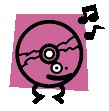

The physical description is an area that is affected greatly by the format of the item being cataloged. Because the purpose of this area is to give a description of the physical type and size of the item being cataloged, the format of that item determines the information recorded. For books, this is done by giving the number of pages, whether or not there are illustrations, and the size of the book. For non-book items, many options are possible, depending on the specific format of the item. The three areas that make up the physical description are extent of item, other details, and dimensions. For a music CD, the rules are as follows:
Give the number of discs, given as ‘1 sound disc’, ‘3 sound discs’, etc. If the playing time can be easily determined, it can be given in parentheses after the number of discs, ‘1 sound disc (75 min.)’
Indicate if the item is digital, then indicate the number of sound channels (stereo, quad.), for example ‘1 sound disc (75 min.) : digital, stereo’
Give the dimensions of the item in standard measures. For music CD’s, this means the diameter of the disc in inches. The standard measure of a music CD is 4 ¾ in., so the information would be shown as ‘1 sound disc (75 min.) : digital, stereo ; 4 ¾ in.’
This example shows the physical description area for a compact disc sound recording:
|
LC Control Number: |
2002569472 |
|
Type of Material: |
Music Sound Recording |
|
Main Title: |
From this moment on [sound recording] / originally recorded by Shania Twain and Brian White. |
|
Published/Created: |
Nashville, TN : Word Music, p2002. |
|
Description: |
1 sound disc : digital, stereo ; 4 3/4 in. |
|
Publisher Number: |
080689 182624 Word Music |
|
Contents: |
High key track -- Low key track -- High key demonstration. |
|
Notes: |
Compact disc. |
|
LC Classification: |
SDA 46118 |
|
Other System No.: |
(DLC) 2002569472 |

One additional piece of information that can be added to the physical description is if there is any accompanying material. This means things like the booklet that often comes with a music CD. It is a good idea to list this accompanying material so that the library staff is aware that there are more pieces that go with the music sound recording. This can easily be done by adding a brief description of the accompanying booklet to the physical description area. The format for the information about the booklet is the same as the format for the physical description for any book item. The record would now look like:
1 sound disc (75 min.) : digital, stereo ; 4 ¾ in. + 1 booklet (10 p. : ill. ; 12 cm.)
While this physical description looks rather lengthy, it does an excellent job of actually describing the item being cataloged.
Many music sound recordings are part of a series, so this area needs to be looked for in the cataloging record and when doing original cataloging. Some recordings are part of an obviously stated series, and some just list a publisher's catalog number on the packaging. Because series can be either useful or unimportant, each library has to determine whether or not to have an access point for each series found when cataloging. Whether or not the library decides to provide access to the title of a series, if there is a recognizable series name on the CD or its packaging, that title should be listed in the series area of the cataloging record. For a card entry, this area is in the same paragraph as the physical description. The title of the series is placed in parentheses, along with a series number if that information is given. For a computer entry, the information is usually listed in the body of the entry, often near the notes area.
SDA
47908 Stan Getz [sound recording]. – [S.l.] : Columbia, p1996.
1 sound disc : digital, stereo ; 4 ¾ in. – (Sony jazz collection)
|
Main Title: |
Stan Getz [sound recording]. |
|
Published/Created: |
[S.l.] : Columbia, p1996. |
|
Description: |
1 sound disc : digital, stereo ; 4³/4 in. |
|
Publisher Number: |
COL 488623-2 Columbia |
|
Notes: |
Compact disc. |
|
Cast: |
Stan Getz, saxophone. |
|
Series: |
The Notes area is the final area of the descriptive cataloging record to look at with a particular material format in mind. There are several types of notes that are important when cataloging music sound recordings. Many times, the information in notes used in the cataloging record for a sound recording helps to provide access points for users finding that item in the catalog. Access points can only be made for information that is included at some point in a cataloging record. Notes provide ways for information not already included in the description to be put into the cataloging record. A cataloger is free to use whatever types of notes seem appropriate for the item being cataloged and the patrons’ needs, but there are some particular notes that are designed for items such as music sound recordings.

Most sound recordings have a number on the item or the packaging that is assigned by the publisher of the recording. This catalog or publishing number (not to be confused with the library catalog number) or publisher number is often a number used when ordering the item or for other purposes by the manufacturer or distributor. Because this number is usually a unique identifying number, like an ISBN would be for a book, this can be a good piece of information to include in the cataloging record. There is no formal note for this type of identifying number in a non-book item record, but it is often included as the first note in the notes area. This is useful mainly for the library staff, if a replacement needed to be ordered, or duplicates were being checked, or that sort of thing. Occasionally it will be of use to the patron who may want to obtain his or her own copy of the recording or who is comparing one recording with another. In looking again at the example from above, the publisher number is shown right below the physical description:
|
Main Title: |
Stan Getz [sound recording]. |
|
Published/Created: |
[S.l.] : Columbia, p1996. |
|
Description: |
1 sound disc : digital, stereo ; 4³/4 in. |
|
Publisher Number: |
COL 488623-2 Columbia |
|
Notes: |
Compact disc. |
|
Cast: |
Stan Getz, saxophone. |
|
Series: |
Title variations notes are very useful for any type of non-book item. It is not uncommon to find the title on the item itself (for example, on the actual CD being cataloged) varies from the title that appears on the packaging for the item (the CD case, in this example). Cataloging rules require that the title in the cataloging record be taken from the actual item, but the patron is often looking at the packaging for that item when finding it in the library shelving. This can cause confusion for patrons and staff members. Using the format illustrated in the cataloging rules, a note could be made that explains this difference in titles. Making this note also allows for an added entry or access point to be made for the title on the container, so that both titles can be located in the library catalog. If this note is used, it needs to be in the style of a formal note, such as:
SDA
37537 Appalachian spring [sound recording] / Aaron Copeland [etc.]. –
copy 1 [S.l.] : Everest, p2000.
1 sound disc : digital ; 4 ¾ in.
VSD 504 Everest
Title on container: Aaron Copeland’s Appalachian spring.
Cast: London Symphony Orchestra ; Walter Susskind
2. Orchestral music. I. London Symphony Orchestra.
II. Susskind, Walter. III. Copeland, Aaron. IV. Title: Aaron
Copeland’s Appalachian spring.
Notice in the example above that when the access point for the title variation is made in card catalog format, the word ‘Title’ is inserted in front of it, to indicate what type of access point is being referred to. If this record was being entered into a computer, probably either the title variation would be entered as a second title, or a MARC record would be used and would indicate that the title variation should be searchable in the computer catalog.

A credit note allows the cataloger to list persons who have made an important contribution to the artistic or technical production of a sound recording (or other type of non-book item). This does not include the cast of a visual or sound recording of a literary work, but does include things like the musicians playing on a sound recording, or a group backing up a lead vocalist, or something similar. Again, using this type of note means that any of the persons or groups listed in the credits could be also listed as additional access points in the cataloging record, allowing library staff and patrons to search for that person or group in the library catalog. Because opening up access points to information in the catalog is an important part of the cataloging process, these options should be used whenever appropriate.
|
Cast: |
Boston Pops ; Arthur Fiedler ; Boston Symphony ; Erich Leinsdorf ; Chicago Symphony ; Fritz Reiner ; Philadelphia Orchestra ; Eugene Ormandy ; Artur Rubinstein. |
The accompanying material note can be used with materials of any format in the library collection. The purpose of this note is to give information about any additional materials that might come with the item being described in the cataloging record. For books, this might be maps, worksheets, stuffed animals, etc. that come along with the book. For non-book materials, this could be items such as booklets, guides, or other materials that come with sound recordings, videos, or other non-book items. Some catalogers choose to list this accompanying material as part of the physical description area, as was shown in an example in that section. Other catalogers choose to list the materials in a note. Either way is correct, and the approach used may be based on a policy in a particular library, or may be left to the discretion of the librarian doing the cataloging. The important thing to remember is to be sure to list accompanying materials somewhere in the cataloging record, so that staff will be aware of what items should be together when materials are checked out or returned. When this note is used, the format should look similar to:
Includes booklet (14 p. : ill. ; 12 cm.)

Another possibly helpful note for many library items is the audience note. This can be used with anything added to the library catalog, but can be useful for sound recordings. The purpose of this note is to give recommendations about the audience for the item being cataloged. Sometimes this intent is very clear from the title or other descriptive information in the cataloging record, but sometimes that is not the case. It is helpful for the librarian to know that this type of note can be added to the cataloging record if needed. For sound recordings, this can be useful in alerting patrons, especially children, of materials that may be either geared specifically for them, or that are not appropriate for their age level. An audience note is generally an informal note, so can be phrased in whatever way the cataloger wishes to convey the information, such as any of these examples:
Intended for elementary age.
Audience: College seminars
Intended for adult audiences.
When an item being cataloged is made up of several or many smaller parts, as sound recordings often are, a contents note can be very helpful. This note can be used to list the various pieces being performed in a sound recording. The decision to use this note is often based on the number of items that might be listed in the contents. If catalog cards are being used, this note can add considerably to the need for additional cards in the card set, both through taking up space in the record and creating the need for multiple cards for each entry, and through the possibility of making extra access points for the titles listed in the contents. This decision must be made based on the needs of the library for which the item is being cataloged. When using a computer catalog, these restrictions no longer exist, so the contents note can be a very useful tool for both staff and patrons. Listing the contents makes it easy for people using the catalog to find out what exactly is on a sound recording. Because the titles of parts of the CD are listed in the contents, access points can then be created for each of those titles, so a patron looking for a particular piece of music or song can easily find out if the library has what he or she wants. This decision must be made with careful consideration of the needs of the patrons and staff, but contents notes are often found to be very useful, especially in small libraries without large collections of whatever item is being cataloged. For example, in the record shown below, having the contents note serves the purpose of letting the catalog user find out what is on this recording, but it also allows the titles in the contents to be searched in a keyword computer search.
|
LC Control Number: |
94752540 |
|
Type of Material: |
Music Sound Recording |
|
Main Title: |
Bells for all seasons [sound recording] : the handbell artistry of Lois Holland. |
|
Published/Created: |
Nashville, Tenn. : Holland, p1982. |
|
Related Names: |
|
|
Description: |
1 sound disc : digital, stereo. ; 4 3/4 in. |
|
Publisher Number: |
KLP-1001 Holland |
|
Contents: |
Golden memories -- His eye is on the sparrow -- The cross -- My country, 'tis of thee ; Faith of our fathers -- How great Thou art -- I'll fly away ; Jesus is coming again -- Thanksgiving praise -- What child is this? -- Silent night -- Christmas medley. |
|
Cast: |
Lois Holland, handbells, flute and keyboards ; Ken Holland, keyboards, bass, guitar and percussion. |
|
Subjects: |
Handbell music. |

Sometimes, particularly in sound recordings, an item being cataloged is made up of one or more parts but does not have what is called a collective title. This can happen often with classical recordings where there may be two or three different pieces, by the same or different composers, on one sound recording. All three pieces may be listed on the CD and the container, but there is no overall title describing the item, and none of the pieces is listed in a way that shows it to be the main focus of the recording. When this happens, the cataloging record can be done in two different ways.
The first option is to list all of the titles in the title area, one after the other, each with their statement of responsibility if those are also different. Examples of this type of entry are shown in the cataloging rules manual. This can be a reasonable option if there are just two different titles, or if the pieces are all by the same composer, but if there are several titles and composers to list in the title area of the cataloging record, it may be confusing or hard to read for staff and patrons alike. Here is an example of a recording with a piece by Mozart and a piece by Schubert. Here both titles are listed in the title/statement of responsibility area:
|
LC Control Number: |
86753400 |
|
Type of Material: |
Music Sound Recording |
|
Personal Name: |
|
|
Main Title: |
Sonata in D major, K. 448, for two pianos / Wolfgang Amadeus Mozart. Fantasia in F minor op. 103, D. 940, for piano, four hands / Franz Schubert [sound recording]. |
|
Uniform Title: |
|
|
Published/Created: |
New York, N.Y. : CBS Masterworks, p1985. |
|
Related Names: |
Perahia, Murray. prf |
|
Description: |
1 sound disc : digital, stereo. ; 4 3/4 in. |
|
Publisher Number: |
IM 39511 CBS Masterworks |
|
Notes: |
Durations: 22:41; 19:18. |
|
Cast: |
Murray Perahia, Radu Lupu, pianos. |
|
Subjects: |

Another option is to use the “with” note. This note is designed to list the additional parts that are in the item being cataloged, besides the title given in the descriptive part of the cataloging record. This is a very simple note to do, and like many of the other notes listed above, allows for the cataloger to then add access points for the titles and/or composers or performers listed in the note. This note differs from the contents note in that contents are listed for items that have a collective title, a title for the item overall, and then parts listed as the contents of that title. The “with” note implies that there is no collective title, so the parts need to each be listed in some way in the cataloging record. Here is another record for the item shown above, this time done using the “with” note to list the second title:
Mozart, Wolfgang Amadeus, 1756-1791.
Sonata in D major, K. 448, for two pianos [sound recording] / Wolfgang
Amadeus Mozart. – New York : CBS Masterworks, p1985.
1 sound disc (23, 19 min.) : digital, stereo ; 4 ¾ in.
IM 39511 CBS Masterworks
With: Fantasia in F minor op. 103, D. 940, for piano,
four hands / Franz Schubert.
“Digitally recorded live at The Maltings, Snape, England.”
Performed by Murray Perahia, Radu Lupu, pianos.
1. Sonatas (Pianos (2)). 2. Piano music (4 hands). I. Schubert,
Franz, 1979-1828. Fantasien, piano, 4 hands, D.940, F minor. 1985.
II. Perahia, Murray. III. Lupu, Radu. IV. Title. V. Title: Fantasia in F
minor op. 103, D. 940, for
piano, four hands.
As shown in this example, listing both titles in the record allows the cataloger to then provide access to both composers and the titles of both pieces. In addition to the two subject headings, access has been made for the second composer, the two performers, and the titles of both works on this recording. The same access points are also provided in the computer format that has both titles listed in the title/statement of responsibility area. With computer formats, the access points are not listed at the bottom of the record like in card catalog format, but those access options are still available.
Click the arrow below to continue.